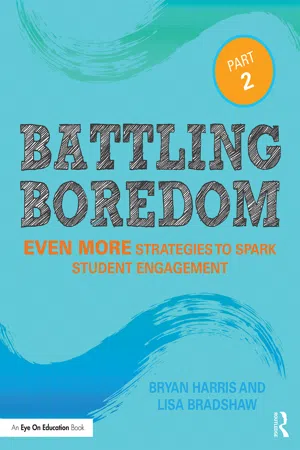
eBook - ePub
Battling Boredom, Part 2
Even More Strategies to Spark Student Engagement
This is a test
- 114 pages
- English
- ePUB (mobile friendly)
- Available on iOS & Android
eBook - ePub
Book details
Book preview
Table of contents
Citations
About This Book
Drive boredom out of your classroom—and keep it out—with the student engagement strategies in this book. In the first Battling Boredom, bestselling author Bryan Harris offered strategies on beginning a lesson, ending a lesson, small group work, and large group work. Now in Battling Boredom Part 2, Harris teams up with technology integration expert and former teacher Lisa Bradshaw to provide additional strategies on new topics such as academic talk, feedback, writing, classroom technology, and more. You'll learn how to:
-
- Increase the quality and effectiveness of feedback to boost student performance.
-
- Engage students in meaningful reflection with writing prompts and exercises.
-
- Reenergize a lethargic class using movement-based activities.
-
- Integrate technology to create a more enriching classroom experience for students.
-
- Encourage students to speak up, share their ideas, and talk about their learning.
With this toolbox of instructional strategies, you'll have even more ways to end student boredom before it begins, resulting in class time that's more efficient, more educational, and loads more fun!
Frequently asked questions
At the moment all of our mobile-responsive ePub books are available to download via the app. Most of our PDFs are also available to download and we're working on making the final remaining ones downloadable now. Learn more here.
Both plans give you full access to the library and all of Perlego’s features. The only differences are the price and subscription period: With the annual plan you’ll save around 30% compared to 12 months on the monthly plan.
We are an online textbook subscription service, where you can get access to an entire online library for less than the price of a single book per month. With over 1 million books across 1000+ topics, we’ve got you covered! Learn more here.
Look out for the read-aloud symbol on your next book to see if you can listen to it. The read-aloud tool reads text aloud for you, highlighting the text as it is being read. You can pause it, speed it up and slow it down. Learn more here.
Yes, you can access Battling Boredom, Part 2 by Bryan Harris, Lisa Bradshaw in PDF and/or ePUB format, as well as other popular books in Pedagogía & Educación general. We have over one million books available in our catalogue for you to explore.
Information
Part One
Academic Talk
Introduction
Key Idea: Academic talk and academically focused conversations are powerful and effective ways to boost student engagement. When students spend time talking about what they are learning, they become more engaged and they remember more of what they are learning. Quite simply, a quiet classroom where students spend the majority of their time sitting and listening will not lead to engagement, deep learning, or long-term memory.
In the 2014 book, Creating a Classroom Culture that Supports the Common Core, Bryan wrote extensively about the power and impact of academic conversations as they relate to student engagement and achievement, particularly in light of the expectations of the Common Core Standards. While a review of that book is not necessary here, it is important to take a moment to provide some basic definitions and insights into the role of academic talk.






1.What is your own personal tolerance level? Some teachers, by nature or personality, simply prefer a quiet environment. Other teachers don’t mind the noise. The point is that yo...
Table of contents
- Cover-Page
- Half-Title
- Series
- Title
- Copyright
- Contents
- Acknowledgments
- About the Authors
- Introduction
- Part I Academic Talk
- Part II Energizers
- Part III Feedback
- Part IV Questioning
- Part V Technology
- Part VI Vocabulary
- Part VII Writing
- Part VIII Student Engagement Strategies that Don’t Work
- References